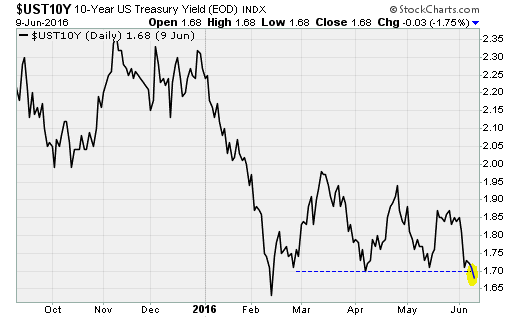What investors have to worry about: nearly everything
Just days after the Dow Jones industrials index traded above the 18,000, recapturing that psychological benchmark for the first time since April, investor sentiment suddenly turned cold.
A list of concerns rattled a number of other asset classes, with knock-on consequences for stocks. The CBOE Volatility Index (VIX), known as Wall Street's "fear gauge," surged up and out of a tight three-month sideways pattern, thanks to its largest one-day gain since January. Crude oil has fallen back below the $50-a-barrel threshold. And bonds are soaring, pushing yields down to levels not seen since the chaos at the start of the year.
With a major Federal Reserve policy meeting looming on Wednesday -- featuring a press conference, updated economic projections and new rate hike forecasts -- the situation is on a knife's edge in a way that investors haven't seen for months.
Government bonds worldwide have been rallying, pushing U.S. 10-year yields under 1.7 percent -- a level last hit during the stock market rout at the beginning of the year. German 10-year bund yields traded below 0.03 percent. Around $10 trillion in global government bonds are now trading with a negative yield, a vote of no confidence in the recovery from fixed-income traders.
This is being driven in large part by Brexit fears in Europe (following the release of a surprise poll showing growing support for "Leave") and jitters about a more hawkish-than-expected outcome from the Fed, which would be a policy mistake at this time, in the bond market's estimation.
The latter is in response to evidence of labor market tightening, a surprisingly measured response to a weak May payroll report from Fed Chair Janet Yellen and weeks of confident commentary from other Fed officials that the central bank could manage two, three, or even four rate hikes in 2016.
The Brexit concerns have been magnified by the fact the "Remain" campaign strategy has relied on fear-mongering about possible financial market turmoil should the European Union lose one of its main members. But it seems, for now, to be having the opposite effect on British voters. This is yet another echo of the establishment-vs.-democracy dynamic that has been in play since the eurozone debt crisis first appeared in 2010 amid violent protests in Athens and resulting in the Greek bailout referendum last year.
The consequent drop in bond yields is putting the hurt on big bank stocks. That's because the gap between short-term and long-term interest rates -- which directly hits profitability via the banks' net interest margins-- is falling. Traders are responding, pushing stocks like Bank of America (BAC) lower.
As for crude oil, West Texas Intermediate dropped back below $50 a barrel on Friday following an increase in U.S. drilling rig counts and production. U.S. crude output has jumped by the most since the first week of January, and rig counts are up by the most since December. They've now risen for two weeks in a row.
Energy companies are responding to the near doubling of oil prices since February. But stocks are vulnerable to an ongoing pullback in oil prices via energy sector default worries (which would further pressure banks) and anxieties over the drag on overall corporate earnings.
Whether stocks can quickly recover and push the Dow back over the 18,000 level depends, in large part, on how the market responds to the Fed's big day on Wednesday. With an ongoing earnings recession (profits down four quarters in a row), a tightening labor market threatening wage inflation, renewed Chinese currency weakness, election uncertainty and a classic supply-vs.-demand response underway in oil, the outlook doesn't look good.
No wonder many are flocking to safe havens such as precious metals. Gold gained 5.3 percent over the last two weeks for its best run in four months. Silver gained 5.7 percent just over the past week, its best result since May 2015.

